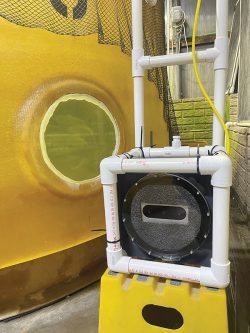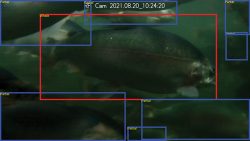
Features
Research
Systems management
Technology
Precision Aquaculture is a step towards smart RAS farming
September 9, 2022 By Rakesh Ranjan
 Kata Sharrer during a data collection event.
Photos: Freshwater Institute
Kata Sharrer during a data collection event.
Photos: Freshwater Institute Though much of the innovation in precision aquaculture is driven by the needs of the coastal, open-system sea cage farms, these technologies can be customized for other production systems including land-based, closed containment operations using recirculating aquaculture system (RAS) technologies.
For more than three decades, The Conservation Fund Freshwater Institute has worked toward innovation, development, and optimization of RAS to improve commercial viability for farmers. Recognizing the enormous potential of cutting-edge smart technologies, we recently added the ‘Precision Aquaculture’ domain to our research program to investigate and adopt precision technologies to solve problems in land-based aquaculture, and to develop knowledge-based decision support for commercial-scale RAS farms.
Precision aquaculture

The imaging platform to collect underwater images in the grow-out tank every 5s.
The term “precision” broadly refers to data-driven management strategies, aiming to improve resource use efficiency, product quality, yield, profitability, and sustainability in production.
Current industry practices typically rely on manual fish handling and management. Manual approaches are subjective and labour-intensive, which adversely affects fish health, welfare, yield, and management decisions. The adaptation of modern sensing technologies and data analytics approaches in aquaculture can assist farmers with knowledge-based decision support to monitor, control, and document biological processes.
Such approaches help in reducing subjectivity and dependency on manual labour through automation, while improving sustainability, fish health, welfare, and productivity. A precision fish farming (PFF) framework developed by Føre et al. (2018) promoted the adaptation of emerging sensing technologies and automated systems to improve fish production.
According to this framework, underwater wireless acoustic sensors, sonar, camera system (visible, multispectral, hyperspectral, stereo vision), water quality sensors, Autonomous Underwater Vehicles (AUVs), etc. can be adopted to make precise and informed decisions on fish biomass, feed optimization, fish health and behaviour monitoring, and disease management. This framework was developed for salmon production in coastal sea cages; however, it can also be implemented for other species and production systems.
Challenges and opportunities in RAS
Harsh environmental conditions, high sensor installation and maintenance costs, limited power and data connectivity, and inaccessibility due to remote locations are some of the major challenge the adaptation of precision technologies at coastal fish farms.
In contrast, RAS enables fish production in a controlled, indoor environment, and therefore, the installation and maintenance costs of sensor nodes are expected to be reduced. Moreover, these sensing and data processing units can take advantage of existing in-house power and communication networks utilized in RAS operations.
Nevertheless, high fish density typical to intensive RAS culture, underwater image distortion, water turbidity, and dynamic targets (i.e., swimming fish) introduce new challenges for quality data acquisition.
Freshwater Institute efforts

Partial and whole fish detected by the developped CNN model.
The Precision Aquaculture group at the Freshwater Institute is focusing on utilizing computer vision and artificial intelligence (AI) to eliminate some of the bottlenecks in current RAS management practices.
Individual fish detection in an industrial-scale, high density RAS tank is a crucial and challenging problem. A computer vision system integrated with an efficient fish detection algorithm could assist in non-invasive monitoring of fish health and welfare, biomass estimation, and feed optimization.
Our team is working on the development of a convolutional neural network (CNN) trained in-tank fish detection model for real-time identification of fish (partial or whole) in the field of view of the vision system. Machine learning is a data-intensive process, and the performance of a CNN model vastly depends on the image data size and quality. Therefore, selection of effective imaging sensors and data acquisition protocols plays an important role in the development of a robust object detection model.
Taking this into consideration, we have developed an imaging platform with an onboard red-green-blue (RGB) color sensor customized for underwater image acquisition. This imaging platform can be programmed to automatically capture images/videos inside the tank for an extended time at a user-defined frequency.
Additionally, an LED light grid was fabricated to provide supplemental light during data acquisition. For the development of the fish detection model, around 8,000 images were acquired in a semi-commercial fully recirculating grow-out RAS tank stocked with rainbow trout (density=40 kg/m3, average weight=4.5 kg).
The acquired images were annotated, pre-processed, and divided in the training, validation, and test dataset prior to training the CNN model. Thereafter, the model was optimized for sensor selection, light conditions, and various model hyperparameters.
The optimized fish-detection model effectively detected whole and partial fish in the test image with satisfactory performance (mAP > 85%; mean average precision (mAP) is an important indicator of the model performance).
The model was also deployed on a video feed of a camera system to track the real-time movement of individual fish and their swimming pattern. This information can be used to investigate the effect of various physical and biological stresses on fish behaviour.
Real-time monitoring of fish activity during a feeding event can also be utilized to optimize fish growth and FCR and to minimize wasted feed through automated adjustment of the feed delivery rate.
Additionally, future research plans include the development of a computer vision tool for non-invasive biomass prediction to eliminate the handling stress associated with manual measurements. We look forward to sharing outcomes from pertinent investigations and further exploring applications of such technologies to improve RAS productivity.
References
- Føre, M., Frank, K., Norton, T., Svendsen, E., Alfredsen, J. A., Dempster, T., … Berckmans, D., 2018. Precision fish farming: A new framework to improve production in aquaculture. Biosystem Engineering 173, 176–193.
- Precision Agriculture Definition. International Society of Precision Agriculture (ISPA).
- O’Donncha, F., Grant, J., 2019. Precision aquaculture. IEEE Internet of Things Magazine 2(4), 26–30.
- Rakesh Ranjan is a research scientist leading the Precision Aquaculture program at The Conservation Fund Freshwater Institute. The Precision Aquaculture team includes Rakesh Ranjan, Kata Sharrer, Scott Tsukuda, and Christopher Good.
Print this page
Advertisement
- MAH’s Jackie Zimmerman joins Northwest Aquaculture board
- Research and benefits of Pichia guilliermandii in shrimp feeds





